LAB REPORT
Science and Technology Making Headlines
Dec. 19, 2014

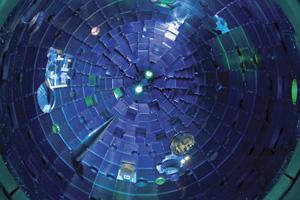
NIF’s target chamber is where the magic happens — temperatures of 100 million degrees and pressures extreme enough to compress the target to densities up to 100 times the density of lead are created there. Photo by Damien Jemison/LLNL
NIF hits the top 10
Physics World, an international monthly magazine published by the Institute of Physics, has named the National Ignition Facility’s (NIF) achievement of fuel gain one of its top 10 breakthroughs of the year.
Ignition — the process of releasing fusion energy equal to or greater than the amount of energy used to confine the fuel — has long been considered the "holy grail" of inertial confinement fusion science. Before achieving ignition, a key step along the path is to have "fuel gains" greater than unity, where the energy generated through fusion reactions exceeds the amount of energy deposited into the fusion fuel and alpha-particle self-heating of the fusing region.
NIF — the world’s largest and most energetic laser — was the first facility to ever reach the milestone of achieving fuel gains greater than 1 with significant levels of alpha-heating. In a paper published in the Feb. 12 online issue of the journal Nature, scientists detailed a series of experiments conducted on NIF, which showed an order of magnitude improvement in yield performance over past experiments.

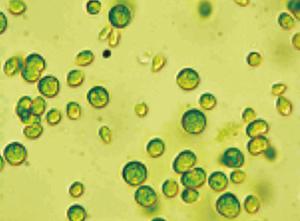
Lawrence Livermore researchers have discovered that cells of the alga Chlamydomonas Reinhardti (seen under a microscope) build a “pantry” to store metal and maintain equilibrium.
A cupboard like no other
Lawrence Livermore National Laboratory researchers in conjunction with collaborators at the University of California, Los Angeles have found that some cells build “cupboards” to store metals.
Nearly 40 percent of all proteins require metal ions such as zinc, copper, manganese or iron for activity.
“We don’t understand very well how cells maintain balance when the cell is stressed by metal excess or metal deficiency,” said LLNL researcher Jennifer Pett-Ridge. “By storing the metal in a special intracellular compartment, the cell creates a bit of a pantry for itself and can better maintain its equilibrium.”
How this matchmaking of metals and proteins occurs with such precision has been a puzzle in cell physiology. The researchers shed new light into how such partnerships are maintained even under stressful conditions of metal deprivation.

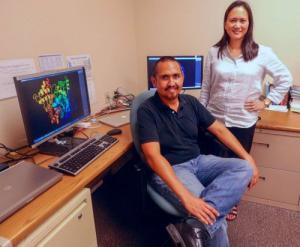
Monte LaBute and Felice Lightstone test the docking of drug molecules to proteins in the human body to look for adverse side effects. Photo by Julie Russell/LLNL
Attack on drug side effects
Side effects from medication killed 117,750 people last year in the United States.
Nationwide, drug side effects take the lives of nearly the number of people who die every year from diabetes, flu and pneumonia combined.
A team of scientists at Lawrence Livermore harnessed supercomputers to simulate drug interactions on human tissue and identify potentially lethal problems. The machine could be used to assess new drugs before they reach the market. Lead researcher Monte LaBute, a scientist in Lawrence Livermore’s computational engineering division, does mathematical modeling of cardiovascular and other diseases.
The research project could have huge implications for the pharmaceutical industry.

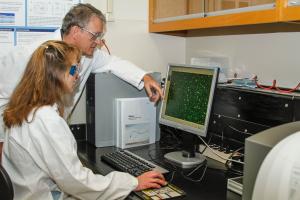
Shea Gardner, a bioinformaticist at Lawrence Livermore National Laboratory, and Tom Slezak, the Lab's scientific leader for Bioinformatics, are using the Microbial Detection Array to combat "everything." Photo by Julie Russell/LLNL
8,000 microbes and counting
Imagine a single test that checks for 8,000 different microbes.
It’s not a far-fetched idea. The test is being used at the Kansas State University College of Veterinary Medicine, where Professor Raymond Rowland is experimenting with what he calls “Star Trek technology.”
The Microbial Detection Array, an invention of Lawrence Livermore National Laboratory, is designed to check samples of blood, dirt, tissue and nasal or saliva swabs for viruses, bacteria and fungi. The test could be used in animal health, public health, vaccine safety, food safety and biodefense.
The Microbial Detection Array, or “everything test,” is designed to look at endemic diseases, emerging diseases and diseases not present in the United States.

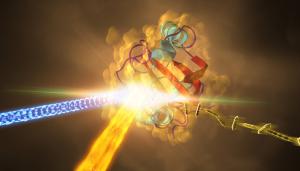
This artist’s rendering depicts an experiment at SLAC that revealed how a protein from photosynthetic bacteria changes shape in response to light.
A tool to track life's chemistry
An international team, including scientists from Lawrence Livermore, has caught a light sensitive biomolecule at work with an X-ray laser. The study proves that X-ray lasers can capture the fast dynamics of biomolecules in ultra-slow-motion nano-movies.
The team captured the highest-resolution protein snapshots ever taken with an X-ray laser, revealing how a key protein in a photosynthetic bacterium changes shape when hit by light.
Human biology is a massive collection of chemical reactions and all involve proteins, known as the molecules of life. Scientists have been moving steadily toward their ultimate goal of following these life-essential reactions step by step in real time, at the scale of atoms and electrons.
The results have implications for research on some of the most pressing challenges in life sciences, which include understanding biology at its smallest scale and discovering molecular targets for drug design.





